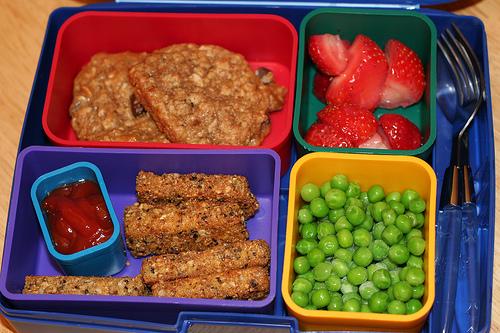A vegan diet, which is free of any animal products, can adequately meet the nutrient needs of a rapidly developing toddler as long as proper planning is involved. As with any diet, parents must offer a variety of healthy foods to avoid nutrient deficiencies and ensure proper weight gain. A vegan diet must include a reliable source of vitamin B12, most commonly found in animal products, and offer sufficient calories and fat for the growing 1- to 3-year-old child.
Choosing the Right Foods
Step 1
Plan on offering three small meals a day plus snacks. Limit fluids other than water between meals to prevent toddlers from filling up on beverages. Toddlers may not eat much at a time due to their developing sense of independence, small stomachs and decline in growth.
Step 2
Aim to provide 40 to 50 percent of calories from fat by offering foods high in monounsaturated fats, like avocados, nut butters, dried fruit, tofu and non-hydrogenated oils. Include a source of linolenic oil, found in canola oil, soy products and flaxseed oil, which promotes the synthesis of DHA.
Step 3
Avoid offering too much fiber, which can take away from a food’s calorie content. Don’t give toddlers anything made with wheat bran. Do offer whole wheat grains, which offer important minerals, but balance it out with enriched pasta and peeled fruits and vegetables, which are lower in fiber.
Step 4
Offer at least 25 grams of protein a day. Adequate amounts of protein will come naturally if toddlers are consuming enough calories. Soymilk, veggie dogs and deli slices, tofu, beans and bread are high in protein.
Step 5
Plan out meals using green leafy vegetables, tofu and fortified soymilk, almonds, figs and legumes–all of which are high in calcium and vitamin D.
Step 6
Ensure toddlers are getting enough vitamin B-12, a nutrient that maintains healthy nerve cells and red blood cells. While there is no reliable vegan source of vitamin B12, it can be found in nutritional yeast and fortified foods. You may want to offer a supplement to be safe.
Step 7
Provide food high in zinc and iron. It’s not uncommon for toddlers to be deficient in iron, so make sure to offer iron-fortified cereal, tofu, seeds, nuts, dried fruits, beans, green leafy vegetables and grain products. Products with vitamin C, like orange juice, aid in iron absorption.
Step 8
Offer two or more servings of vegetables and two or more servings of fruit a day.





